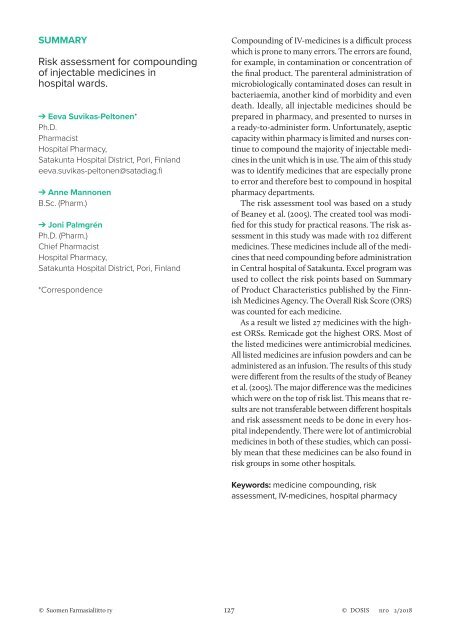DOSIS 2/2018
Farmaseuttinen aikakauskirja DOSIS 2/2018 vol.43 Suomen Farmasialiitto ry
Farmaseuttinen aikakauskirja DOSIS 2/2018 vol.43 Suomen Farmasialiitto ry
You also want an ePaper? Increase the reach of your titles
YUMPU automatically turns print PDFs into web optimized ePapers that Google loves.
SUMMARY<br />
Risk assessment for compounding<br />
of injectable medicines in<br />
hospital wards.<br />
➔ Eeva Suvikas-Peltonen*<br />
Ph.D.<br />
Pharmacist<br />
Hospital Pharmacy,<br />
Satakunta Hospital District, Pori, Finland<br />
eeva.suvikas-peltonen@satadiag.fi<br />
➔ Anne Mannonen<br />
B.Sc. (Pharm.)<br />
➔ Joni Palmgrén<br />
Ph.D. (Pharm.)<br />
Chief Pharmacist<br />
Hospital Pharmacy,<br />
Satakunta Hospital District, Pori, Finland<br />
*Correspondence<br />
Compounding of IV-medicines is a difficult process<br />
which is prone to many errors. The errors are found,<br />
for example, in contamination or concentration of<br />
the final product. The parenteral administration of<br />
microbiologically contaminated doses can result in<br />
bacteriaemia, another kind of morbidity and even<br />
death. Ideally, all injectable medicines should be<br />
prepared in pharmacy, and presented to nurses in<br />
a ready-to-administer form. Unfortunately, aseptic<br />
capacity within pharmacy is limited and nurses continue<br />
to compound the majority of injectable medicines<br />
in the unit which is in use. The aim of this study<br />
was to identify medicines that are especially prone<br />
to error and therefore best to compound in hospital<br />
pharmacy departments.<br />
The risk assessment tool was based on a study<br />
of Beaney et al. (2005). The created tool was modified<br />
for this study for practical reasons. The risk assessment<br />
in this study was made with 102 different<br />
medicines. These medicines include all of the medicines<br />
that need compounding before administration<br />
in Central hospital of Satakunta. Excel program was<br />
used to collect the risk points based on Summary<br />
of Product Characteristics published by the Finnish<br />
Medicines Agency. The Overall Risk Score (ORS)<br />
was counted for each medicine.<br />
As a result we listed 27 medicines with the highest<br />
ORSs. Remicade got the highest ORS. Most of<br />
the listed medicines were antimicrobial medicines.<br />
All listed medicines are infusion powders and can be<br />
administered as an infusion. The results of this study<br />
were different from the results of the study of Beaney<br />
et al. (2005). The major difference was the medicines<br />
which were on the top of risk list. This means that results<br />
are not transferable between different hospitals<br />
and risk assessment needs to be done in every hospital<br />
independently. There were lot of antimicrobial<br />
medicines in both of these studies, which can possibly<br />
mean that these medicines can be also found in<br />
risk groups in some other hospitals.<br />
Keywords: medicine compounding, risk<br />
assessment, IV-medicines, hospital pharmacy<br />
© Suomen Farmasialiitto ry 127<br />
© <strong>DOSIS</strong> nr0 2/<strong>2018</strong>

















